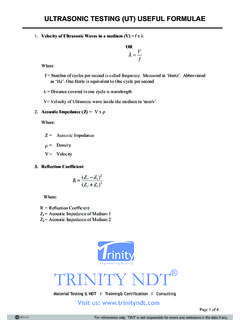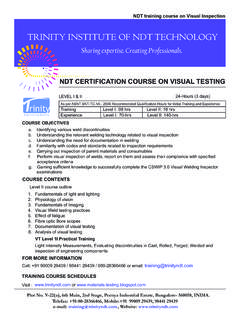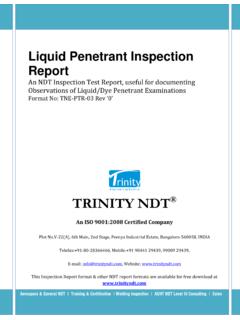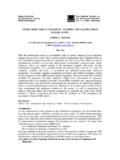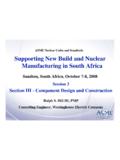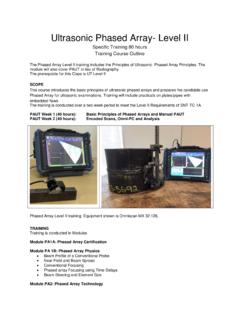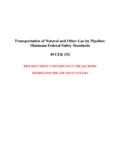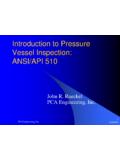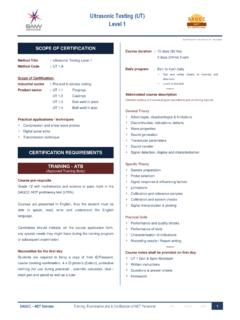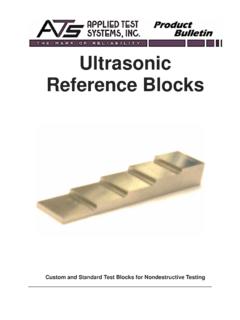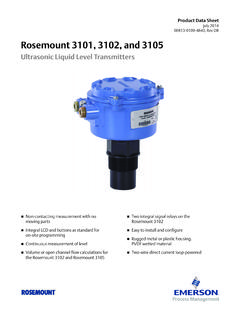Transcription of Liquid dye penetrant test inspection free ndt sample ...
1 NDT Procedure for Liquid penetrant inspection A Nondestructive testing (NDT) Procedure suitable for General Liquid /Dye penetrant Inspections. This is a sample LPT procedure and may be required to be modified as per specific requirements. NDT Procedure No: TNE-DOC-LPT-05 Rev 0 TRINITY NDT An ISO 9001:2008 Certified Company Plot (A), 6th Main, 2nd Stage, Peenya Industrial Estate, Bangalore-560058, INDIA Telefax:+91-80-28366466, Mobile:+91 98441 29439, 99009 29439, E-mail: Website: This NDT inspection Procedure & other NDT procedures are available for free download at Aerospace & General NDT Training & Certification Welding inspection ASNT NDT Level III Consulting Sales TRINITY NDT An ISO 9001.
2 2008 Certified Company PROCEDURE FOR Liquid penetrant EXAMINATION Procedure No. TNE-LPT-Doc-05 Rev 0. This procedure & other NDT procedures are available for free download at ` 1. Scope This Test method covers procedures for penetrant examination of butt and fillet weld with the associated Heat Effected Zone (HAZ) on the parent metal and components. They are non-destructive testing methods for detecting discontinuities that are open to the surface such as cracks, porosity and lack of fusion by Liquid penetrant testing conducted in accordance with the requirements of the referenced Codes and Standards.
3 2. Purpose The purpose of this procedure is to explain the method of applying the Liquid penetration non-destructive test. 3. References ASME Code Section V -applicable edition/addenda. ASME Code Section I -applicable edition/addenda. ASME Code Section VIII, Div1-applicable edition/addenda. ANSI/ASME , applicable edition/addenda. AWS - applicable edition. ASTM-E165-Standard Test Method for Liquid penetrant Examination. Clients specification requirements for acceptance criteria.
4 TNE Written Practice Note: In case of conflict between Code requirements and Client s specifications, Code requirements shall prevail. 4. Definitions PT : penetrant Examination Trinity NDT Procedure for Liquid penetrant Examination Page 2 of 6 5. Responsibilities The NDT Inspector shall be responsible for conducting and reporting the results of inspection in accordance with project contract. 6. Personnel Qualifications All personnel involved in penetrant Examinations shall be qualified in accordance with the Requirements of Trinity NDT Written Practice for NDE Personnel Qualification.
5 When the written practice is revised, the certification of NDE personnel remains valid to the requirements of the previous revision until the expiry date of the personnel qualification certificate; then, recertification to the requirements of the new revision is required. The certification of personnel shall be checked by the QA/QC Manager prior to work commencement. 7. Procedure This procedure shall be demonstrated prior to use in accordance with the requirements of T-150, ASME Code Sec. V. The procedure qualification record shall be attached to this procedure.
6 Equipment: Solvent Removable Visible Dye penetrant materials consist of: a) penetrant . b) penetrant remover/cleaner. c) Developer. d) Lint free cloth. e) Light meter capable of measuring visible light intensity in lux / foot candles ( ). The light meter shall meet the calibration requirement of T-660 of ASME Code Section V Materials: Only materials of a recognized commercial quality shall be used as identified by the manufacturer s name Ardrox, Ely Chemicals or Magnaflux or as specified by the client.
7 penetrant materials of the same family group shall be used, mix between family groups is prohibited. Certification of contaminant content shall be provided by manufacturers for all Liquid penetrant materials used on nickel base alloys, austenitic or duplex stainless steels, and titanium. These certifications shall include the penetrant manufacturers' batch numbers and the test results obtained in accordance with Mandatory Appendix II of Article 6, ASME Code Sec. V. These records shall be maintained as required by the referencing Code Section.
8 Trinity NDT Procedure for Liquid penetrant Examination Page 3 of 6 Surface Condition: Generally satisfactory results may be obtained when the surface of the part is in the as-welded, as-rolled, as-cast, or as forged condition. Surface preparation by grinding, machining, or other methods may be necessary where surface irregularities could mask indications of unacceptable discontinuities. Precautions shall be made with the mechanical cleaning not to close the discontinuities open to the surface.
9 Etching of the cleaned surfaces may be necessary to open the discontinuities. Prior to all Liquid penetrant inspections, the surface to be examined and all adjacent areas within at least 25mm (1 ) shall be dry and free of dirt, grease, lint, scale, welding flux, weld spatter, oil and other extraneous matters that could obscure surface openings or otherwise interfere with the examination. Typical cleaning agents that may be used are detergents, organic solvents, descaling solutions and paint removers. Degreasing and ultrasonic cleaning methods may also be used.
10 Method: Surface Cleaning process: a) Solvent cleaning method: On removal of any rust, scale, welding flux, spatter, and in general, inorganic soils, the surfaces to be inspected shall be cleaned, with solvent cleaner and then finally with a dry lint free cloth. Drying Process: a) The drying process shall be accomplished by normal evaporation. Minimum time allowed for drying is 1 minute to ensure that the cleaning solution has been evaporated prior to application of the penetrant . Application of penetrant : a) After the area has been cleaned, dried and the temperature of the surface and penetrant are within the range of 40 F (5 C) to 125 F (52 C), the penetrant shall be sprayed directly to the surface to be inspected by means of aerosol container, so that the entire area under inspection is completely covered.

